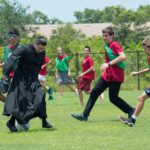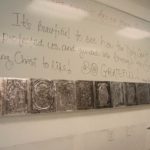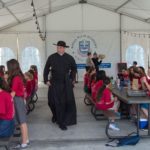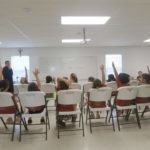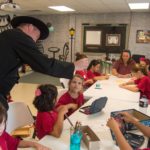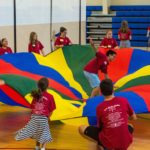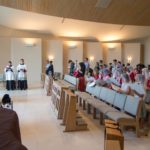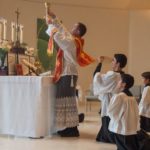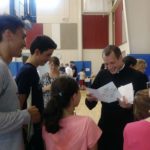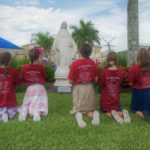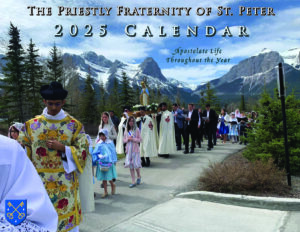September 11th, 2001: Requiéscant in Pace

Today marks 18 years since the series of four terrorist attacks that occurred on September 11th, 2001 and took the lives of almost 3,000 people. Though the statistics and figures are often quoted on this day, perhaps just as often we simply ask one another, “Where were you on 9/11?”, so etched is it in the minds of those of us who were old enough to remember what happened on that Tuesday morning in New York City, Washington D.C. and Shanksville, Pennsylvania. We can’t forget. It defined our country’s collective existence for years after.

This day is a time to remember all those who died that day, including the first responders who gave their lives in the line of duty. It was the deadliest terrorist attack in history and the deadliest incident for firefighters and law enforcement officers in American history. Many too have given their lives in the long conflicts that rapidly followed. As time wears on and the new generation, born after 2001, reaches adulthood, it is easy to let the events of that day fade in our memory. But for those of us who remember where we were on 9/11, and, we pray, for all who come after us, may we always forgive, but may we never, ever forget. +
Réquiem ætérnam dona eis, Dómine: et lux perpétua lúceat eis. Requiéscant in pace. Amen.
September 11, 2019
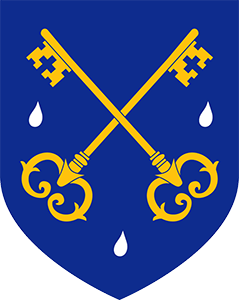
From the Heart
In a diminutive office on the second floor of a humble building in San Diego, a remarkable rescue mission is underway.
The office belongs to our apostolate just down the street, the church of St. Anne, which offers the use of its space to a small group of dedicated souls who comprise Children of the Immaculate Heart, an organization devoted to the service of victims of human trafficking. Begun 6 years ago by director Grace Williams, CIH has seen incredible success with its programs that assist women in escaping from trafficking, building a new life for themselves and finding Christ-centered healing. During a recent trip to San Diego, we had the privilege of talking to Grace and some of her staff about their work, the inspiration behind it and the kind of results they are seeing in San Diego.

Grace is originally from the Central Coast of California, near Monterey. A convert to the Faith from Protestantism, her conversion began when a Mormon friend asked why they were so many Christian denominations. She considered it a good question, and thought about how unity was so important to Our Lord, as evidenced by His high priestly prayer recounted in John’s Gospel, the last prayer before His Passion. She realized that Christians needed to be one.
Another critical moment came while she was on a study abroad program to Geneva and Rome in 2004. A non-Catholic professor on that trip conveyed to his students that we as Christians had to base what we believe on what Christians had always believed.
“So what did they believe at the beginning?. . . for a thousand years, we basically all believed the same thing,” said Grace, following the thought pattern laid out by her professor.
The beauty of the churches in Rome was another spark that fell on Grace’s soul during that trip.
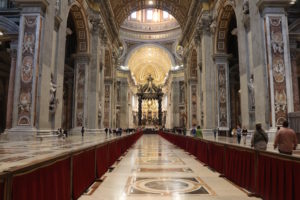
“I was so moved, and I was also suspicious that I was moved,” she laughed. “It was slowly starting to bring the Incarnation to life, because for that type of Protestant, faith is something in your head, it’s something you assent to intellectually, but there’s nothing that makes it physically lived.”
Soon after, she came to a sudden realization that Christ was in Heaven with the same Body, albeit glorified, that He possessed on earth, that He had become Man and that that fact was never going to change.
“Everything that that means for our humanity just completely exploded in the best possible way,” she said.
Although she never harbored anti-Catholic sentiments, any prejudices she may have had evaporated upon meeting seminarians and priests from the Pontifical North American College in Rome and hearing their vocation stories. She had never seen such a radical following of Christ, such a total and free dedication of the self to God.
“I don’t get it,” she remembers thinking, “but these people are the real deal.”
Back in the States, she began to take classes at a Catholic college, met other Catholics and gradually found answers to her various questions. She entered the Church two years later in 2006.
The seeds of Children of the Immaculate Heart were sown in 2012 when she was on a pilgrimage led by a priest friend of hers. He and some of his friends had felt called to work for an end to abortion and trafficking, seeing them as linked. He explained to Grace that they saw Christ in these victims, and to Grace, it made perfect sense. She too began to see the suffering Christ in the women and girls caught up in the trafficking cycle: they were betrayed by those closest to them, sold for money, beaten, stripped, publicly humiliated. The Church’s teaching on the dignity of the person and of women in particular were big factors in her conversion, and this further helped her to see the importance of this work.
Although up to that point she had no intentions of working in this field – she had spent time at a Carmelite convent and was intending to enter a Benedictine community where she had been accepted – Children of the Immaculate Heart was founded in October 2013 under the spiritual guidance of Fr. Carl Gismondi, pastor at the time of St. Anne Parish. Famous among parishioners for his project-oriented mindset, Fr. Gismondi encouraged Grace to “just do it” and begin the work to which she was being called. He it was who suggested that they take Our Lady as their patroness under her title of the Immaculate Heart.
CIH’s motto is “To Restore All Things in Christ.” The group focuses on rehabilitation programs for trafficking victims, providing services such as therapy, a weekly support group and assistance with housing, transportation and basic needs for women over 18. The clients come to them in various ways, often as referrals from other clients, programs that can’t take them or law enforcement. They focus on women with children, since these women can rarely get help from other programs which, for the most part, only accept single women.
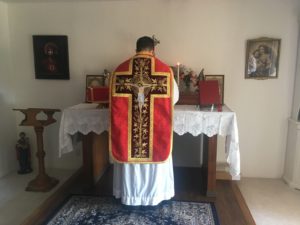
CIH is also in the last round of state approvals for a residential house for 12 – 17 year olds. The goal of opening such a house has been integral to the mission of CIH from its founding, as it was a central part of Grace’s initial motivation. The new house, called the Refuge, will provide full board, education, therapy, including specialty therapies such as music and equine therapy, character formation and instruction in basic life skills for up to 6 girls. Working with a charter school that provides the curriculum and oversight, the house provides complete on-site education, with a 1-3 teacher/student ratio and the goal  of catching each girl up to grade level by the time she leaves. The beautiful Spanish-style home has been lovingly readied in preparation for its imminent opening, is set on 1.5 acres of land and includes such amenities as a spacious deck and yard, a classroom stocked with books and its own chapel.
of catching each girl up to grade level by the time she leaves. The beautiful Spanish-style home has been lovingly readied in preparation for its imminent opening, is set on 1.5 acres of land and includes such amenities as a spacious deck and yard, a classroom stocked with books and its own chapel.
Regarding the results they have seen among their adult clients, Grace calls their journeys “slow but sure progress.” She notes that the more they are able to do for a client and the longer she has been with CIH, the better her chances of success. Rather than merely giving them handouts, CIH strives to form long-term relationships with their clients, to walk with them in their journey of personal growth and to encourage them to form good habits and take ownership of their lives. The staff gave some examples of clients who have done just that. Citing one who has been with them 4 years, Grace notes how her spiritual growth has contributed to her success.
“For her what has made her succeed is making the choices to cut off bad friends,” says Grace. “That’s what she’s done more than any other client…I really think it is just through her prayer and her own reflection and choices that she just has more clarity.”
Another former client, described by Grace as their best success story, has a brilliant mind and essentially read her way out of the trafficking life. She is now highly successful in the workforce, but what is more, she is also a devout Catholic, who maintains Mass, holy hours and prayer as staples in her schedule.
“[She] probably will be a saint someday,” says Grace. “She’s just amazing.”
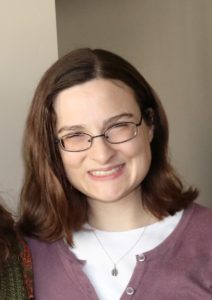
Margaret Boharic is the secretary of CIH. She was introduced to Grace through a mutual friend – all three had spent time at different Carmelite communities at various points in time.
“There’s a Carmelite backdrop to this whole thing,” said Margaret. An attendee of their yearly Gala might notice that the tablecloths are a suspiciously Carmelite-like shade of brown, complemented by Marian blue.
After discerning out of the religious life, Margaret basically came for a visit to San Diego and never returned to her native Chicago. She is trusted and well-liked by the clients, which is an indicator of a compassionate spirit.
“With the people who work here,” Grace explained, “there are just some people [who] through their own life experiences, through their own prayer life and contact with God, for whatever reason, have empathy and compassion, and the clients know it immediately. There’s a certain degree to where you just can’t train someone to do this…Margaret is one of those naturals.”
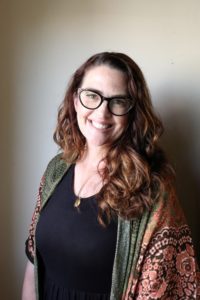
Amy Sorenson shares that same spirit. She joined the CIH team in January and will be the administrator and house manager for the Refuge. In addition to her passion for the issue and her love for working with trafficking victims, she brings invaluable professional experience to the team. She worked as a victim advocate for 10 years in San Bernardino County and after moving to San Diego 5 years ago, gained specific experience in running residential facilities. In a word, she is perfect for the job.
“I prayed and prayed and prayed and prayed to be here,” she said. “I feel very blessed.” She considers it a privilege just to know the clients she serves, to hear their stories and to be a source of support for them. “They are the people who’ve taught me so much,” she said.
Children of the Immaculate Heart is now a fixture among the anti-trafficking efforts at work in San Diego, and is reachable via the 211 anti-trafficking hotline. A full list of clients further testifies to the copious fruits of their labors. If you would like to assist with their work, you can learn more and donate at their website, www.childrenoftheimmaculateheart.org. There are opportunities not only for monetary donations, but also for donations of items for their clients and for volunteer work.

Describing the compassionate attitude required for the work that they do, Amy often says “it has to come from your heart.” Indeed, the mission of these three devoted women and all who work with and support CIH is truly a work that comes from the heart, or we might say, from the Heart. +
September 7, 2019

Bishop Schneider to Confer FSSP Priestly Ordination
On Saturday, October 26th, 2019, the Reverend Mr. William Rock, FSSP, will be ordained to the Sacred Priesthood by His Excellency the Most Reverend Athanasius Schneider, Auxiliary Bishop of Astana, Kazakhstan. The ordination will take place at 10:30 a.m. at St. Mary’s Church, our apostolate in Providence, Rhode Island, with first blessings and a reception to follow. Bishop Schneider will celebrate the 8 a.m. Low Mass the following day, Sunday, October 27th, and Mr. Rock will celebrate the 10 a.m. High Mass with first blessings afterwards. All are welcome!
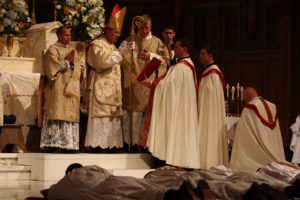
This is the second time the Fraternity has had the privilege of welcoming Bishop Schneider as our ordaining bishop: in May of 2014, he came to St. Cecilia Cathedral in Omaha to confer Holy Orders on seven of our deacons. We are grateful for the opportunity to welcome him once again, and moreover, to one of our own parishes! The beautiful and historic church of St. Mary became an FSSP apostolate last year, with Fr. John Berg, FSSP, assigned as its first pastor.
For more information, you can download the flyer below or visit St. Mary’s website here. More details will follow in coming weeks regarding all the events surrounding the ordination, so stay tuned to the Missive for the latest. If you plan to attend, please RSVP on that same webpage by October 14th, 2019, and be sure to check out the discounted room rate available at the nearby Marriot for ordination attendees.
Please pray for Mr. Rock as he prepares to begin his life as a priest of God! +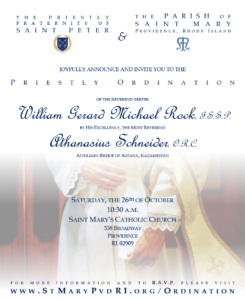
September 3, 2019

The Most Beautiful Thing on Earth
If the name Randy Shed sounds familiar, it might be if you remember the Solemn High Mass that took place at Holy Trinity, the parish on the West Point campus, back in January of this year. It was Major Shed, a captain at the time, who was the mover and shaker behind that event, and he told us more about it, how he came to the Church and to the Latin Mass, and what being a faithful Catholic has to do with being a faithful soldier.
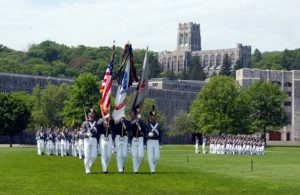
Major Shed hails from Rolla, Missouri, the son of two civilian employees of the Army. In addition to being raised in a military environment and enjoying war films growing up, he was motivated to serve by the events of 9/11 and by a history teacher who would inspire his students with stories from the Civil War and took them to visit the battlegrounds of Gettysburg and Vicksburg. Major Shed subsequently graduated from the United States Military Academy (USMA) at West Point in 2008, and as an infantry officer served two tours of deployment, one each in Iraq and Afghanistan.
A convert to Catholicism, Major Shed’s journey to the Faith began while attending graduate school at Columbia University in New York City. He remembers a teacher speaking on the idea of truth and how truth is subjective. He knew that this was absolutely erroneous.
“It kind of jostled me,” he said. “There’s got to be one truth out there.”
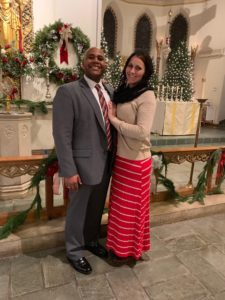
So he began to look at different aspects of his life that this idea of truth could apply to, including his faith. After the birth of their third child, his wife, Major Michelle Shed of the U.S. Army Signal Corps, who was raised Catholic, returned to the Faith of her upbringing. She told her husband that they needed to start practicing the faith that they professed, and she began taking the kids to Mass on Sunday while the other Maj. Shed stayed home. Maj. Shed himself was raised Christian, but had fallen away from regular church attendance.
One Sunday soon after, while Maj. M. Shed and the kids were at Mass, Maj. R. Shed remembers standing in his living room, looking at his dog Molly, who looked back at him as if to say, “You know that you should be there.” Maj. Shed indeed knew that, regardless of his own faith background, he needed to be there with his family. So he told his wife later that as the husband, as the father, as the leader of the household, he considered it imperative that he be there with his family at church, and if Catholic Mass was what they were attending for now, so be it.
He subsequently found himself attending Mass at Holy Trinity Parish at West Point, listening to a sermon by the chaplain, Fr. Pawlikowski, and as Providence would have it, the sermon was on apostolic succession. Fr. Pawlikowski explained that Christ had established a visible Church on earth, which He had entrusted to His Apostles and who had handed it on to their successors. Those successors had, in turn, handed the teachings and traditions of the Church on to their successors and so on, even to the present day. Each Bishop is a successor of one of the Apostles that sat at the feet of Our Lord.
“That absolutely blew my mind,” said Maj. Shed.
He proceeded to return home and devour everything he could find on the Catholic Faith. It wasn’t long before everything began to line up for him, and he entered the Church on Easter 2016.
Maj. Shed first encountered the Latin Mass when Fr. Ken Bolan celebrated a Low Mass at West Point. Even though Maj. Shed couldn’t hear most of what the priest was saying, he was struck by the ostensible sacredness of what was happening. You could tell, he said, that something was going on up there on the altar. In his research he discovered that there was something called a Solemn High Mass in this same “family” of Masses, and he heard his first one at St. Mary’s Church in Norwalk, Connecticut.
“It was the most beautiful thing on earth,” he said. “It was literally Heaven on earth.”
Maj. Shed met the Priestly Fraternity of St. Peter at Our Lady of Fatima Chapel in Pequannock, NJ, where he attended a morning Low Mass and listened to the priests chanting the Divine Office before conversing with them afterwards. Recalling another Low Mass he attended at the National Shrine of St. Alphonsus Liguori, our apostolate in Baltimore, MD, he spoke of the effect the Mass had upon him.
“I remember being able to pray, being able to unite myself, my whole being with what was going on at the altar in an intimate way,” he said.

And certainly this 175-year-old Shrine, with its soaring Gothic Revival arches and celestial sanctuary, draws the soul to the contemplation of the divine. It is also a piece of American history, a Baltimore landmark whose former pastors include St. John Neumann, the fourth bishop of Philadelphia and the first male American citizen to be canonized. It was under the roof of this American treasure that Maj. Shed met a kindred spirit: St. Alphonsus pastor Fr. Joel Kiefer is himself a West Point grad and former Army officer.
There was no question that this beautiful liturgy had taken a profound hold on Maj. Shed. He sought to bring what he had experienced to West Point, and St. Mary’s in Norwalk, with the permission of the priests at West Point, was able to provide it. It was the first Solemn High to be celebrated at the United States Military Academy in decades.
We asked Maj. Shed about his views on being a Catholic soldier. He said he looks to his patron saint, St. Maurice of the Theban Legion, for an example of what it means to be a soldier and an officer. He mentioned that patriotism and love of country are ideals supported by the Church, that principles such as just war theory have their roots in Catholicism and that the ideas of sacrifice and service in Catholicism translate over into the military.
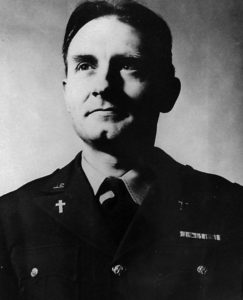
“I also think one of the big things is care of soldiers,” he added. “Catholicism teaches you how to genuinely love the people you are around. What is love? Willing the good of the other as other. As a leader, if you want to lead people, you gotta love them.”
And what he says echoes the words of Servant of God Chaplain Emil Kapaun. He is a beloved figure at West Point, Maj. Shed says, “because of the way he lived his life. Giving the full measure of one’s life for your soldiers in the capacity of chaplain.” Chaplain Kapaun said: “Men find it easy to follow one who has endeared himself to them.”
The Latin Mass has a particular appeal for those in the military, says Maj. Shed, and a desire for it exists within military communities. Referring to the order and discipline with which the Latin Mass is celebrated, he says, “just on the surface, the precision of the movements, the direction, the submission to the rubrics, that is very much woven in the fabric and the understanding of military people. We understand things like drill and ceremony and deeper meanings behind things.”

Maj. Shed strongly supports bringing the Latin Mass into military communities, since he believes it will find a welcome home there. It certainly seems that way from our perspective. The Fraternity not only counts former military men among its priests, but some of our parishes are situated close to military bases and hence see a lot of servicemembers in the pews. And, for the first time, the Fraternity has begun a military chaplaincy with the assignment of Fr. Kenneth Webb to the Canadian Forces Support Unit in Ottawa, Ontario on August 1st.
Now stationed at the Command and General Staff College in Fort Leavenworth, Kansas, the Sheds continue to attend the Latin Mass near their new assignment, often at St. Rose Philippine Duchesne, our apostolate in Kansas City. Through the efforts of those like the Sheds, who found themselves so inspired by the Latin Mass, perhaps “the most beautiful thing on earth” will find its way into many more military communities. It only makes sense that those who live out ideals of sacrifice would be drawn to a liturgy where the idea of sacrifice is so tangible, and those with hearts for tradition would be such fertile ground for the growth of the most ancient and glorious Tradition of them all. +
This story is part of a continuing series highlighting Catholic life in the military and the FSSP’s work with our servicemembers. If you have a story you’d like to share, please send us an email at missive@fssp.com.
August 30, 2019

GOTBeauty? FSSP Naples Hosts Summer Camp
by Ms. Katie Walton
This summer, seventy children came together for the second annual Corpus Christi Summer Camp hosted by Corpus Christi Chapel, the FSSP apostolate in Naples, Florida. The camp took place during the Octave of Pentecost and concluded with a Sung Mass for Trinity Sunday. It was perfect timing since the theme of the camp was “GOTBeauty,” a handy acronym FSSP Naples chaplain Fr. Jonathan Romanoski used to present the four transcendentals of the One Triune God: goodness, oneness, truth and beauty.

Every morning Fr. Romanoski and assistant chaplain Fr. Joshua Passo gave talks to the campers about various aspects of the four transcendentals. Students learned about the beautiful symbolism of the sacred image, Our Mother of Perpetual Help. They discovered that, as sacramentals, relics are gifts of God which help dispose us to grace. They practiced discerning the three qualities of beauty – proportion, integrity and clarity – in sacred art, and they discussed how the music we listen to can affect body and soul. Fittingly for the Octave of Pentecost, they were instructed about the language and symbolism of the Holy Ghost.

After these mini-classes, students had an opportunity to experience the beauty of sacred music with seminarian, Mr. Jared Leonard, and two parishioners, Nicky Rutherford and Katie Walton. Older campers learned how to sing a simple polyphonic Mass, and younger campers learned important chants and hymns including Credo III, Adoro Te Devote, Ave Maria and Soul of My Savior.
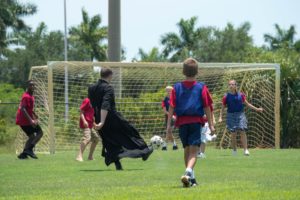
After working hard at singing, campers were able to relax and spend ample time in recreation. Many enjoyed playing soccer with Fr. Passo and Mr. Leonard, despite the Florida heat, while others attempted to capture the flag with counselors Paul Dinan and Danny Battis. In the gym, some campers tried – and often failed – to “knock out” Fr. Romanoski in basketball. Others spent time playing various board games or drawing. Despite the campers’ love for these various activities, the popular favorite was dodgeball, which was played with a serious but charitable spirit of competition.
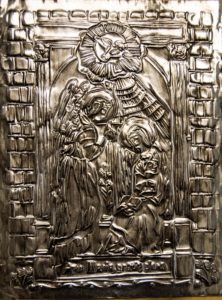
Later on in the day, Mrs. Abril Borjon taught campers to apply their new knowledge of beauty in creating a metal embossed piece of sacred art. Students and parents alike were impressed with the results, and many campers’ bedroom walls will now be adorned with hand-made, beautiful sacred art.
Before the campers left for Vespers each day, Mr. Leonard gave them parting words addressing the different gifts of the Holy Ghost; thus the campers were brought back to where they had started – the Most Holy Trinity.

Each day ended on a high note as campers were given the opportunity to see the transcendentals first-hand through sung Vespers and sung Mass. The entire camp culminated on Trinity Sunday, when campers sang the various pieces they had learned for the greater glory of God and the edification of the faithful. According to one parishioner, she had “never heard anything so beautiful.” It was a satisfying answer to the question – GOTBeauty?
August 28, 2019

FSSP Begins First Military Chaplaincy
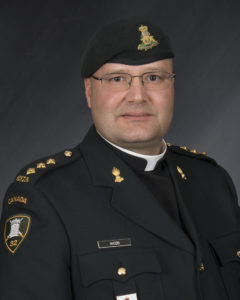
It’s the first time it’s happened for our Fraternity: an apostolate in a military archdiocese, or in this case, a military ordinariate – the Military Ordinariate of Canada, to be exact. Fr. Kenneth Webb, FSSP, most recently the pastor of St. Aloysius Parish, our apostolate in the diocese of St. Catharines, Ontario, took up his new assignment as a full-time military chaplain stationed at the Canadian Forces Support Unit (Ottawa) on August 1st. The Ordinariate works in much the same way as our Archdiocese for the Military Services, in that it is overseen by a bishop and, rather than being bounded by borders, extends to wherever members of the Canadian armed forces serve, at home or abroad. The chaplains who serve within it remain incardinated in their home dioceses or communities, but sometimes (unlike the US) they are incardinated in the ordinariate itself. In this case, Fr. Webb will remain a member of the Fraternity while serving full-time as a military chaplain.
Of course, the Fraternity is no stranger to military ministry, at least on the US side of the border – several of our parishes are situated close to US bases and hence count military families among their parishioners. But with Fr. Webb’s new assignment, a Fraternity priest will be serving for the first time as a full-time military chaplain on a military installation.
We’ll be checking in with Fr. Webb a little later in the year to learn more about his work with the Support Unit. ‘Til then, please pray for him, the military personnel he will be serving and for our success in this new venture. +
August 26, 2019

The Porter of Pilar
by Rev. Mr. Daniel Alloy, FSSP

It’s a humid Saturday morning in Guadalajara, Mexico. Francisco (Paco) Garcia is talking with a homeless man outside Our Lady of the Pillar Church, the FSSP parish in Guadalajara. Paco has to pause every now and then as metrobuses with old or non-existent mufflers roar by on the narrow street. After a few minutes, he helps the homeless man to his feet and invites him into the church.
This homeless man’s name is Alejandro. He is probably about thirty years old, and has been living on the streets of Guadalajara since he was six. When the Fraternity moved to Our Lady of the Pillar in 2011, Alejandro was already living in a niche by the front door. His living quarters consist of a blanket and pillow laid on the stone step, and one crutch for his bad leg. He always has a cheerful smile, and he’ll talk to anyone who stops by.

He is well-known among the priests and parishioners as the “Porter of Pilar” (“pillar” is spelled “pilar” in Spanish, with the accent falling on the second syllable). Many people will come up and talk to him on Sundays after the noon High Mass. But the one who has befriended him more than anyone else is Paco.
Paco is a candidate discerning his vocation with the FSSP, living at Casa Cristo Rey in Guadalajara. Throughout his 16-month discernment period, and even before, he has helped Alejandro on a journey of faith. Despite living in the shadow of a Catholic church (literally), Alejandro has never even been baptized. Once Paco discovered this, he began to mull over a plan.
He began with the Rosary. Once or twice every week, Paco would stay for an hour or more with Alejandro, teaching him to memorize the prayers and use the beads. On those evenings, there is always a steady cacophony of unmuffled buses, and dance music coming from the nightclubs of ill repute. In spite of the sights and smells, these two men quietly pray the Rosary on the church steps.
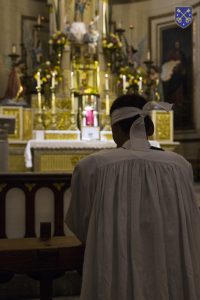
After three months of the Rosary, Paco moved on to the catechism. “The Creed is like a story,” he said, “and I wanted Alejandro to learn it.” Alejandro eagerly soaked up everything. And although he had little educational background, he progressed steadily.
It took several months for Alejandro to memorize the fundamental prayers: the Apostles’ Creed, the Act of Contrition, etc. But Paco is a patient teacher, and eventually, Alejandro could say them on his own. He also began to go to Mass every Sunday. Once, when he missed Sunday Mass at Our Lady of the Pillar, he grabbed his crutch and hobbled over to the next church to hear Mass. His conviction was growing.
One day, a group of Protestant missionaries came up to Alejandro and began discussing faith topics in earnest. They tried to convince him to give up trying to be Catholic. “There isn’t anything special about this place,” said one, pointing at the church. “It’s just a house.”
“Yes,” responded Alejandro, “but it’s God’s house.”
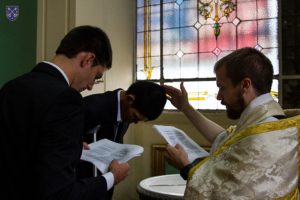
On this humid Saturday morning, Paco and Alejandro are in the church once again. But this is no ordinary Saturday. Today, after a 16-month catechumenate, Alejandro will be baptized a Catholic. He will undergo the ancient and beautiful rite of adult baptism. Rejecting Satan and his pomps, and armed with the five exorcisms of the rite, he will come to the baptismal font to die to his old self, and receive the new life of grace.
Alejandro will also receive Confirmation, taking the name of St. Nicolas. The choice of this patron saint is no surprise, as Our Lady of the Pillar has a side chapel dedicated to St. Nicolas of Bari. Alejandro has spent much of his catechumenate in this little chapel, thus developing a devotion to the famous bishop-saint. Finally, at the Solemn High Mass, Alejandro will receive Our Lord Himself for the very first time.
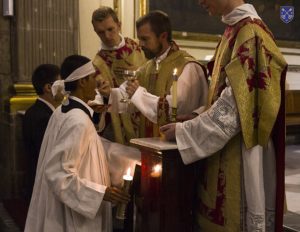
It’s an emotional day for Alejandro, the best day of his life. At the beginning of the baptismal ceremony, wearing a suit that a generous parishioner bought him, tears begin to well in his eyes. This man, who has known a hard and lonely life, is now surrounded by dozens of parishioners, assisting at his baptism, and rejoicing with the newest member of the Catholic Church. He brushes a hand across his eyes, and turns to his sponsor to see which response follows. And it’s no surprise who that sponsor is.
Thanks to Paco’s patience and charity, the Church receives today another lamb into the fold of Christ. Paco said very little about his own role in Alejandro’s journey, but he did make one very telling comment. “I saw Christ in him,” he said.
This is what Our Lord meant when He said: “Amen I say to you, as long as you did it to one of these the least of my brethren, you did it to me” (Matt. 25:40). +
August 23, 2019

Happy Feast of the Immaculate Heart of Mary!

A happy and most glorious feast of the Immaculate Heart of Mary! The most pure Heart of Our Lady, adorned with every virtue, was always united to the Sacred Heart of her Divine Son; indeed, it was from Mary that He took His human Heart. These Hearts loved one another more than we can comprehend, and they suffered in union with one another as well: in Our Lord’s Passion, Our Lady’s Heart was pierced by a sword when Our Lord’s Head was pierced by thorns and His Heart by a lance.
Our Lady’s Heart is filled with love for us too. She is truly our Mother, and her maternal Heart is a refuge for us sinners in all our needs. Whether we need a favor, the conversion of a loved one or anything at all, we should fly to the Immaculate Heart of Mary and she will hear us. Sweet Heart of Mary, be my salvation!
Adeámus cum fidúcia ad thronum grátiæ, ut misericórdiam consequámur, et grátiam inveniámus in auxílio opportúno.
Let us come with confidence to the throne of grace, that we may obtain mercy, and may find grace for a timely help.
– from the Introit for today
August 22, 2019

Fr. Rhone Lillard Featured on Catholic Answers Live
Fr. Rhone Lillard, FSSP, who teaches at Our Lady of Guadalupe Seminary in Denton, Nebraska, recently appeared on Catholic Answers’ show Catholic Answers Live, where listeners can call in and ask questions of the guest. Fr. Lillard spoke on the history of the FSSP and answered such questions as how to discern between a diocesan and religious priest vocation, if you can use grape juice instead of wine in the Mass, and how to best participate in the Mass if you can’t receive Communion.
The segment featuring Fr. Lillard begins at about the 58:52 mark, and we’ve preset the video below to start right then. So just press play and enjoy the segment!
August 19, 2019

FSSP Appears in Legatus Magazine
The FSSP recently appeared in the August edition of Legatus Magazine, the monthly publication of Legatus, an international organization of Catholic business leaders. The article by Trent Beattie highlights the work of the FSSP, particularly at our apostolates in Baltimore, Maryland and Coeur d’Alene, Idaho. The article appeared both in print and online, and you can click the link below to read it!
https://legatus.org/finding-reverence-in-abundance-with-priestly-fraternity-of-st-peter/
August 16, 2019



